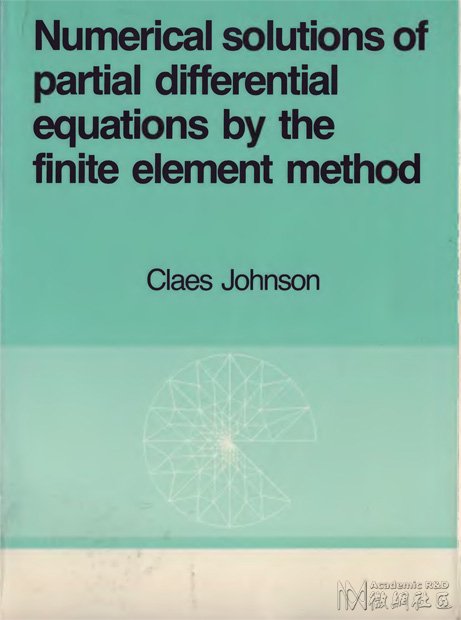本帖最后由 kerbcurb 于 2013-3-15 19:38 编辑
Claes Johnson
Numerical solution of partial differential equations by the finite element method

Preface
The purpose of this book is to give an easily accessible introduction to the finite element method as a general method for the numerical solution of partial differential equations in mechanics and physics covering all the three main types of equations, namely elliptic, parabolic and hyperbolic equations. The main part of the text is concerned with linear problems, but a chapter indicating extensions to some nonlinear problems is also included. There is also a chapter on finite element methods for integral equations connected with elliptic problems. The book is based on material that I have used in undergraduate courses at Chalmers University of Technology, Goteborg. The first half of the book (Chapters 1-7), which treat elliptic problems in a rather standard way, is a translation of a textbook in Swedish that appeared 1981 [ji] Two chapters on parabolic and hyperbolic problems present recent developments based on my work on discontinuous Galerkin and streamline diffusion type finite element methods using, in particular, finite elements for the time discretization as well. For first order hyperbolic problems these are the first finite element methods with satisfactory properties and thus show promise of extensive applications. For parabolic problems, time-discretization by the discontinuous Galerkin method gives new efficient methods and makes a precise error analysis with associated automatic time step control possible for the first time.
The emphasis of the text is on mathematical and numerical aspects of the finite element method but many applications to important problems in mechanics and physics are also given. I have tried to keep the mathematics as simple as possible while still presenting significant results and maintaining a natural mathematical framework. Lately I have used the text of the book as part of the material in a series of undergraduate courses on partial differential equations leading up to graduate level treating in integrated form both mathematical questions on existence and regularity together with numerical methods. I have found this to be a fruitful approach where, on one hand the numerical methods can be given the necessary mathematical background, and on the other hand, the fascinating and important techniques of solving differential equations numerically using computers can give crucial motivation for the theoretical mathematical studies. In fact, the numerical and mathematical aspects are intimately connected and the new possibilities of computer simulation makes proper understanding of the mathematical structure and properties of the mathematical models very important also in applications. In the present book only a bare minimum of mathematical background is included and the reader is referred to the literature for a more complete account.
The list of references is limited and many contributions important for the development of the various subjects have been omitted. I have given just a few references leading into the very rich literature on finite element methods.
I want to thank Prof Raymond Chandler for revising the English, Tekn Lie Peter Hansbo for supplying most of the numerical results and Dr Kenneth Eriksson for reading parts of the material. Special thanks also to Mrs Yumi Karlsson who swiftly typed a first version of the text and with great patience helped me with seemingly endless alterations and corrections.
Goteborg in July 1987 Claes Johnson


